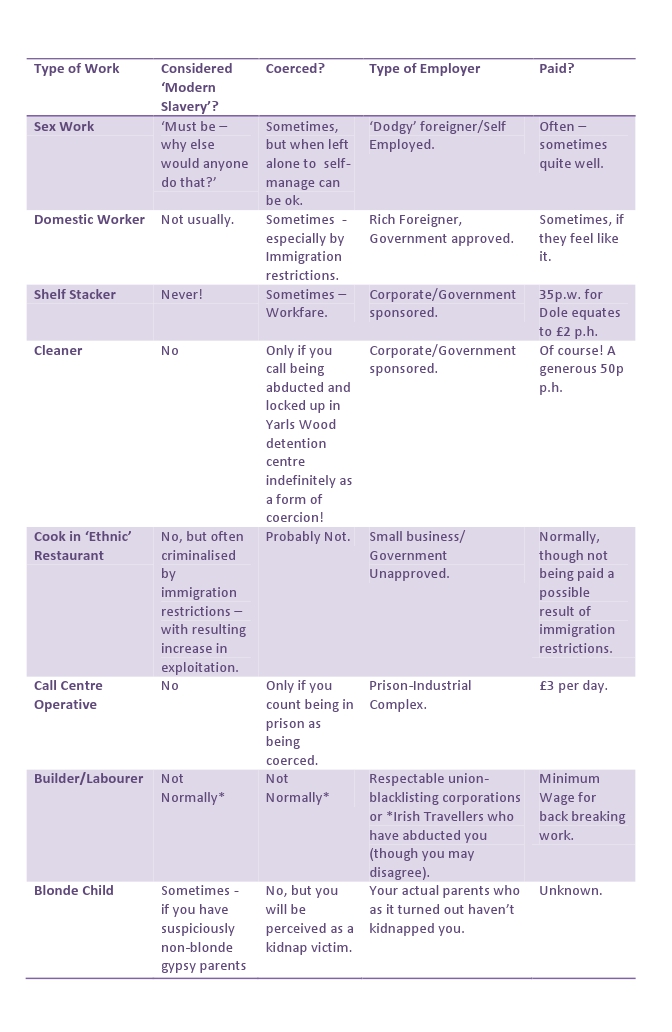As the “Modern Slavery” Bill is made into law, some of you may be left wondering whether you are a slave or not. Here is a simple guide for the perplexed.

We can all agree that slavery is bad, right? Real bad. We thought we had done with all that ages ago but apparently there is this thing called ‘Modern Slavery’. Unlike slavery in the past – for instance the triangular trade – it isn’t sanctioned by the British State, or British Corporations – it’s illegal – or if its not – it’s about to be. Teresa May says so.
Definitions
So, what is this ‘Modern Slavery’? Well, for a start ‘Modern’ here simply means contemporary. Nothing to do with ‘Modernism’ – this seemed to cause some confusion amongst some intellectuals at a Conference: “Slaveries Old and New: The Meaning of Freedom” -which this piece is largely based on. Guys, the British Government isn’t about to legislate retrospectively on the period 1870-1945.
‘Slavery’ is more tricky to define then you may think – especially if you are looking for a definition which can accomodate slaveries’ both old and new. I would suspect that most people when you mention the word ‘slavery’ think of the plantation of the Caribbean and the Americas, the often fatal and mass transportation of Africans to those places – and perhaps ancient slavery in Greece and Rome. This doesn’t sound too much like Modern Slavery. Trafficking of People – a oft used example of Modern Slavery happens in secret, perhaps with a handful of people being transported at once -either against their will (sometimes) or at least with some kind of deception involved. Working on a cocoa plantation, or perhaps quarrying (especially as a child) are more tasks we associate with slave-like conditions. Some of this work is done to pay off a debt -so is unpaid – but is still servicing a debt nonetheless (perhaps has more in common with the coolie labour system that replaced slavery on abolition?) This still isn’t Chattel Slavery. The debts will (at least theoretically) be paid off. The classic example being women who were promised ‘good’ jobs being lured into sex work. They are not subsequently sold on the open market as African slaves were. That’s not too say that it’s not pernicious.
One of the key features missing from contemporarily configured slavery is legal ownership of one person by another. In most forms of ‘old’ slavery – Greek, Roman, Saxon down to the triangular trade – one person was another persons (legal) property to do with as they wished (chattel slavery). This was enshrined in law. Such ownership is of course, anathema today and if it exists at all it is outside of the law – it is all ready criminal – so we may ask :What is the purpose of the new legislation?
Perhaps people mean this when they say ‘Modern Day Slavery’.
So are there any common features between slavery modern and old? There does seem to be two key features. Coercion and poor working conditions. That that the labour is not entered into voluntarily ( that there is no legal contract). Labour is not given freely, and it is unpaid. There are a couple of features here. One that unfree labour is intrinsically bad (or even “Evil” – as it says on many anti-slavery posters) and that the non-contractual element of the relationship allows unjust labour relations and unacceptable working conditions to flourish. or to put is another way, the labour relations are so that one party dominates another.
So, are we to conclude that all labour that is coercive and has poor working conditions counts as slavery? I think we concede then we are not saying that Modern Day Slavery isn’t really like Old Slavery. What we are talking about is a variety of work which is coerced. But this is question begging – who is coerced, by whom, within what context?
This seems an especially pertinent questions as while some types of forced or coerced Labour are labelled “Modern Day Slavery”, others are not. The table above probably gives us some clues as to why. There clearly is a right way to exploit, and a wrong way.
Spot the Difference
This TedX Talk on Modern Day Slavery was shown as a example of the main stream narrative on the matter at the British Academy conference. Its heroic white rescuer (Photographer Lisa Kristine) presented some undoubtedly appalling (and even some unargubaly slave-like conditions). But her illustration of ’emancipation’ merely replaced the hideous, gruelling, unpaid labour with hideous, poorly paid, gruelling, labour at a stone quarry in Uttah Pradesh and was therefore somewhat underwhelming. In her own words :
“…now that they do the same back-breaking work but they do it for themselves and they get paid and they do it in freedom”.
Great.
